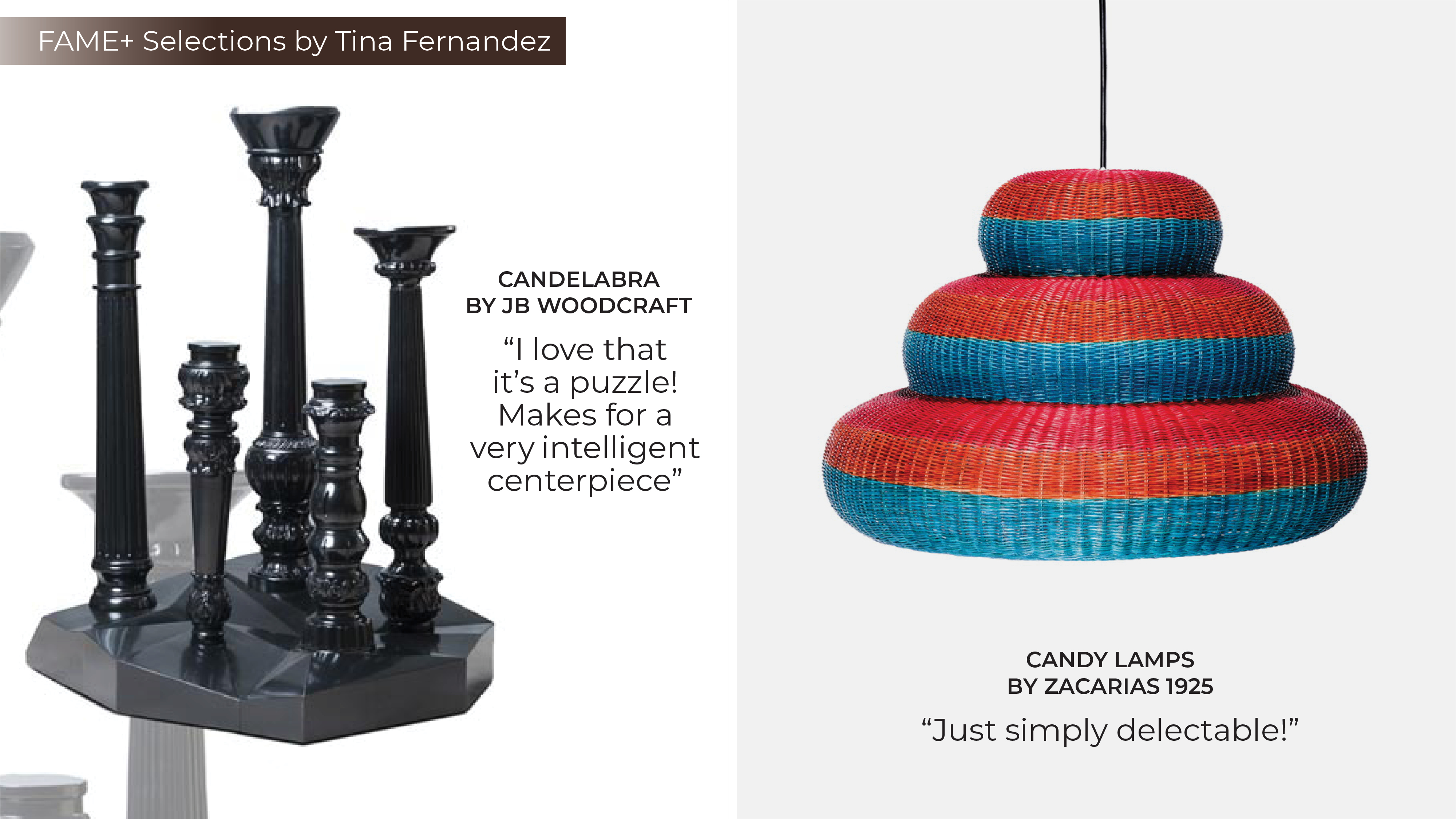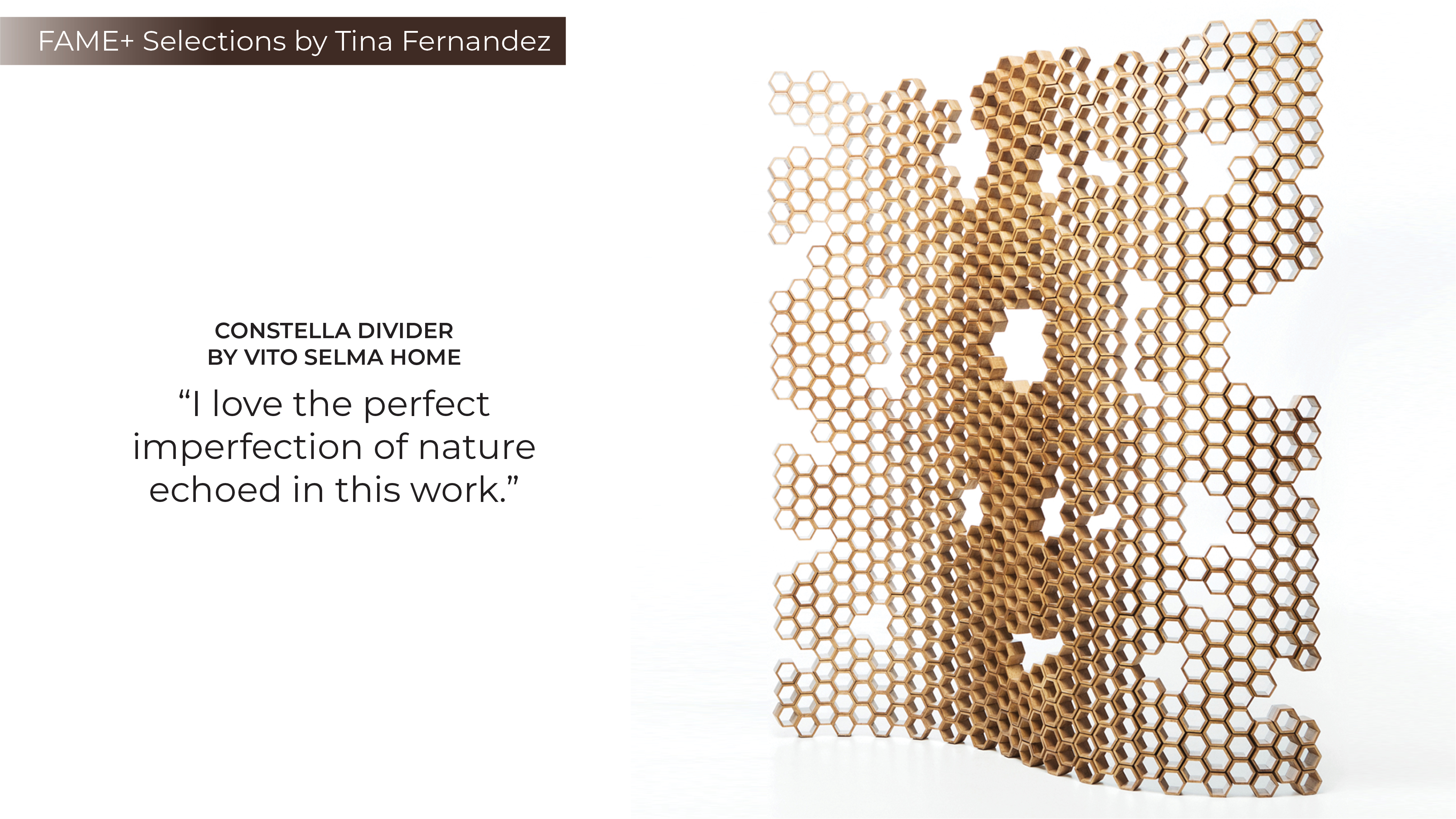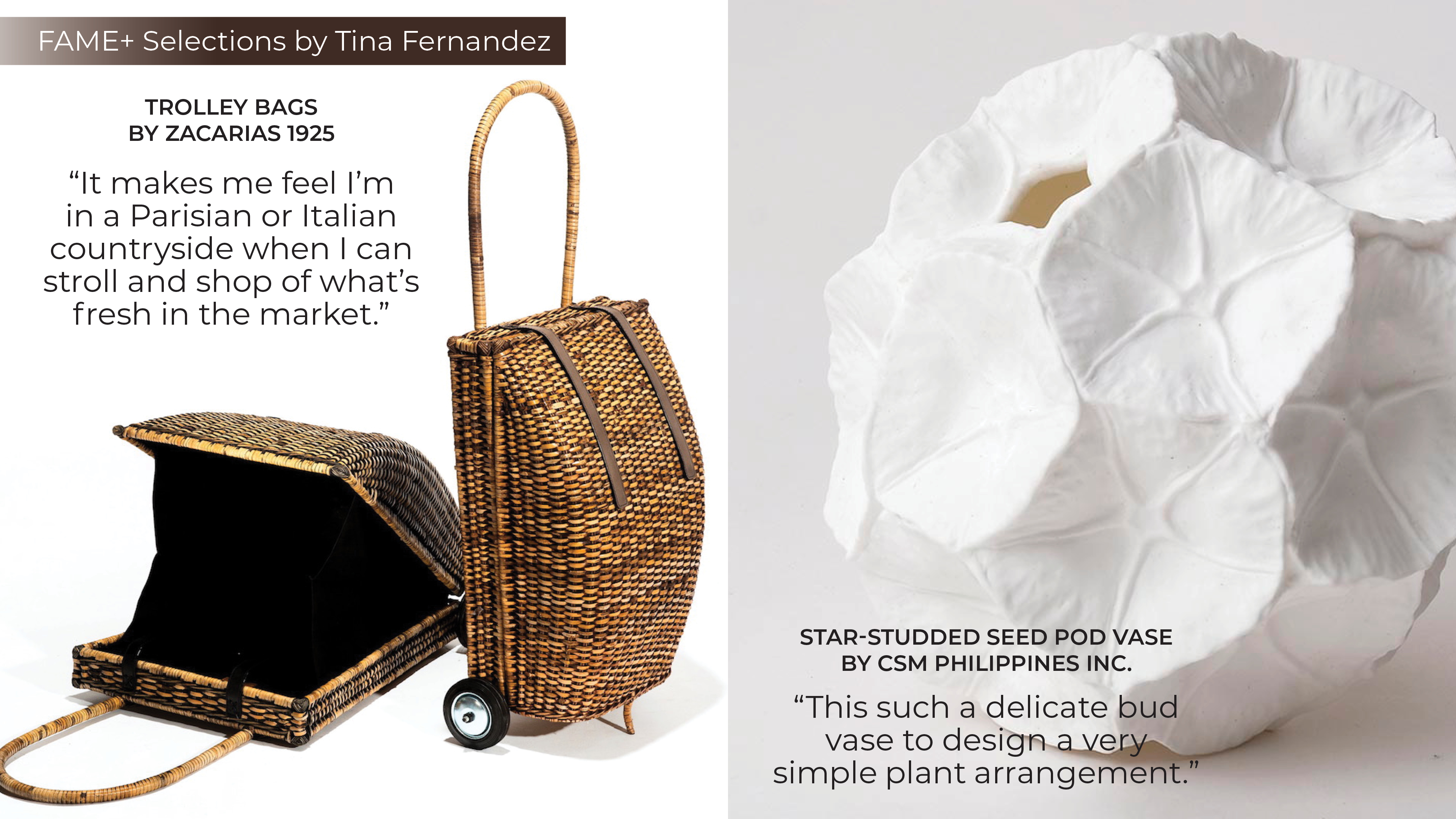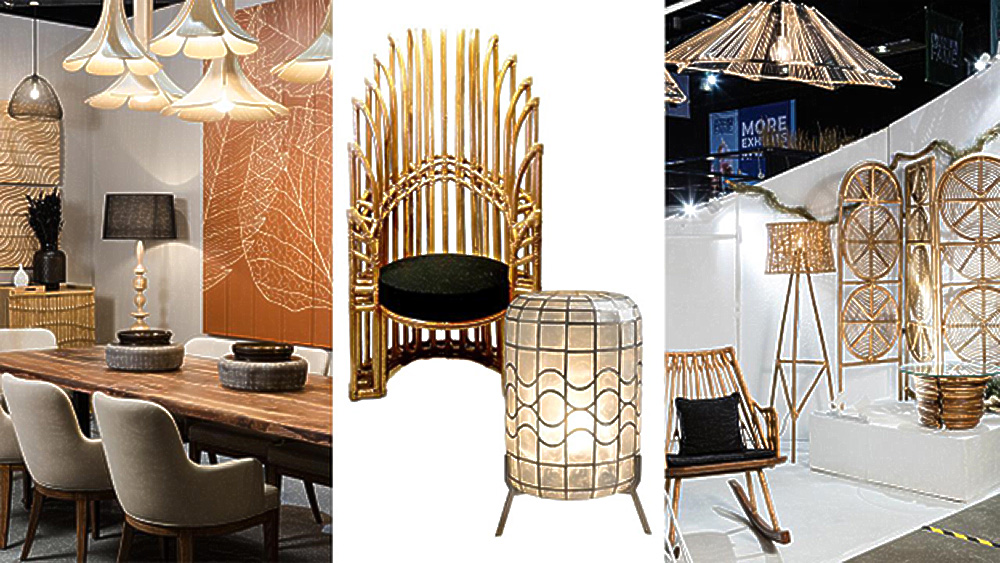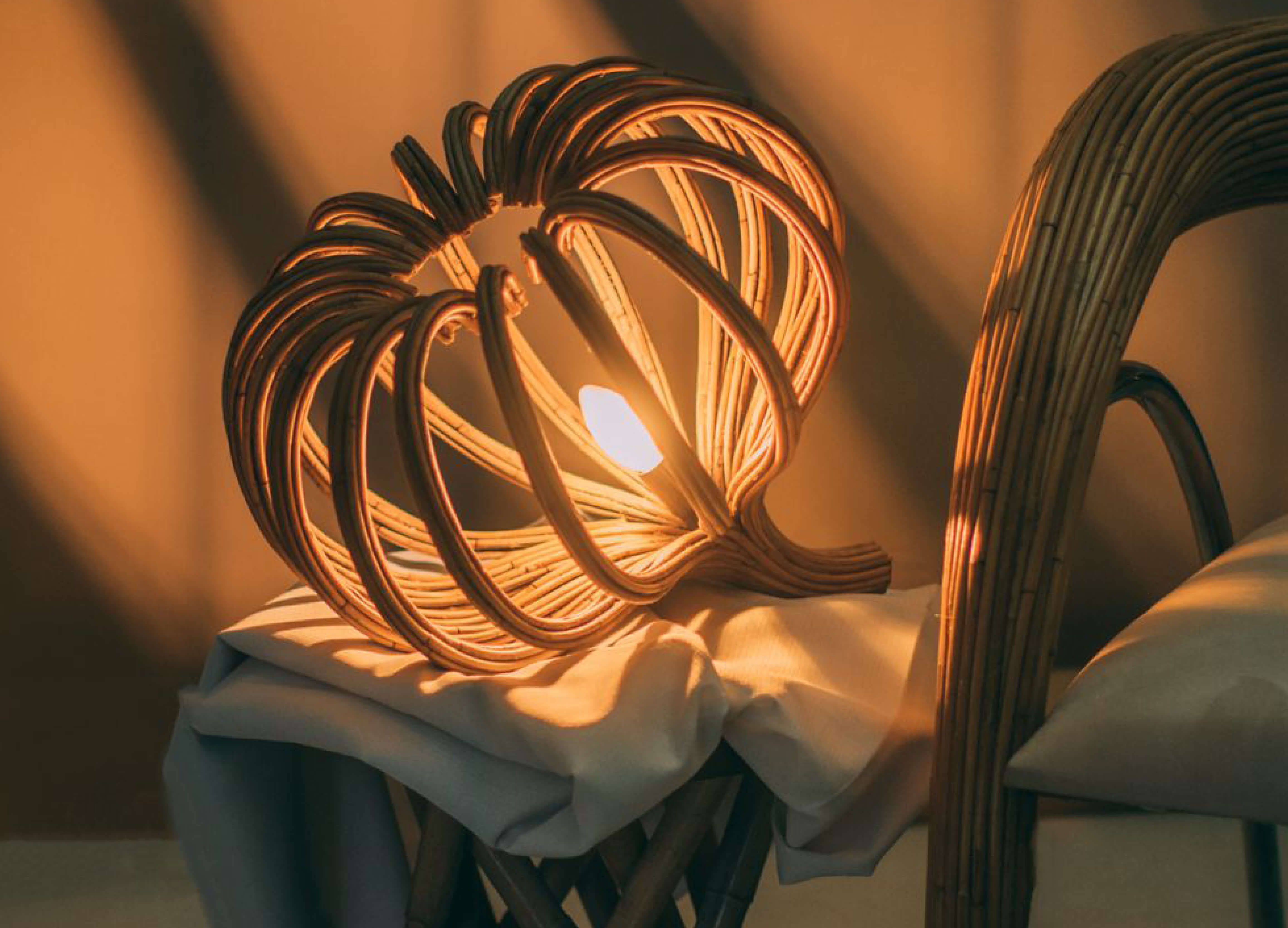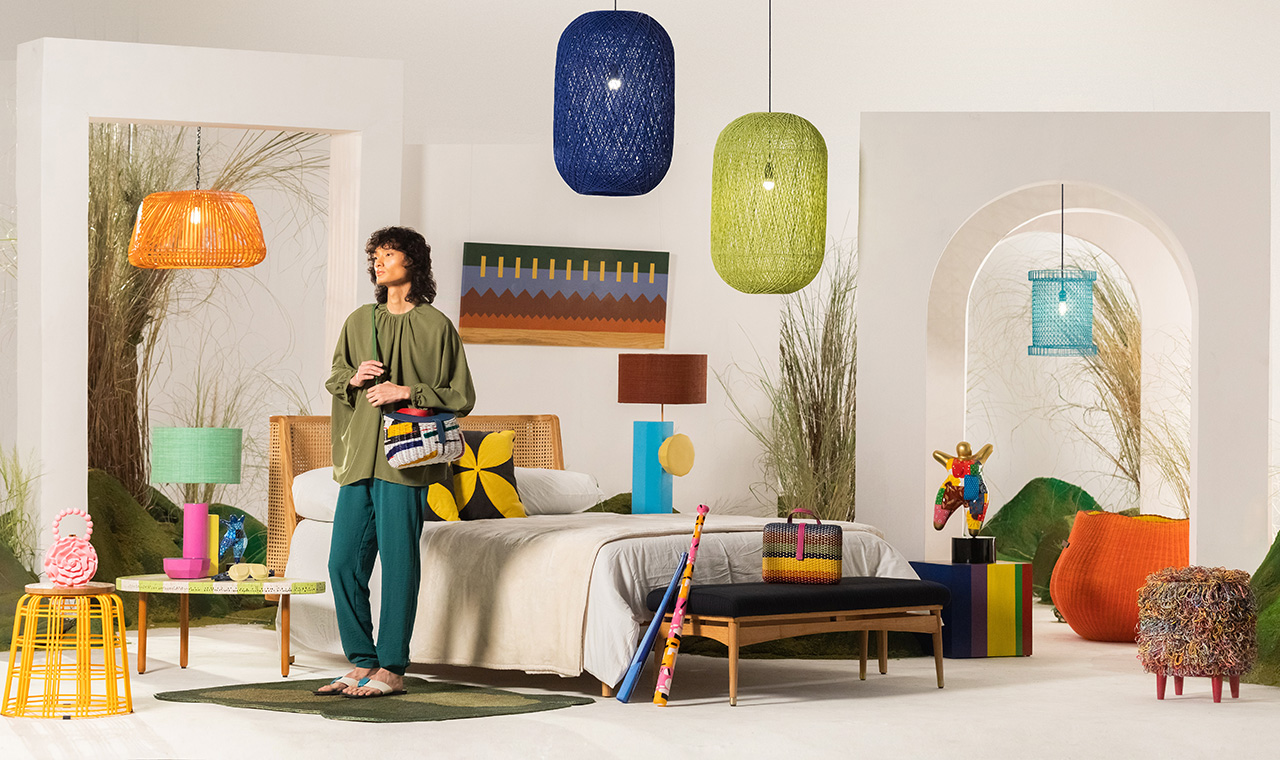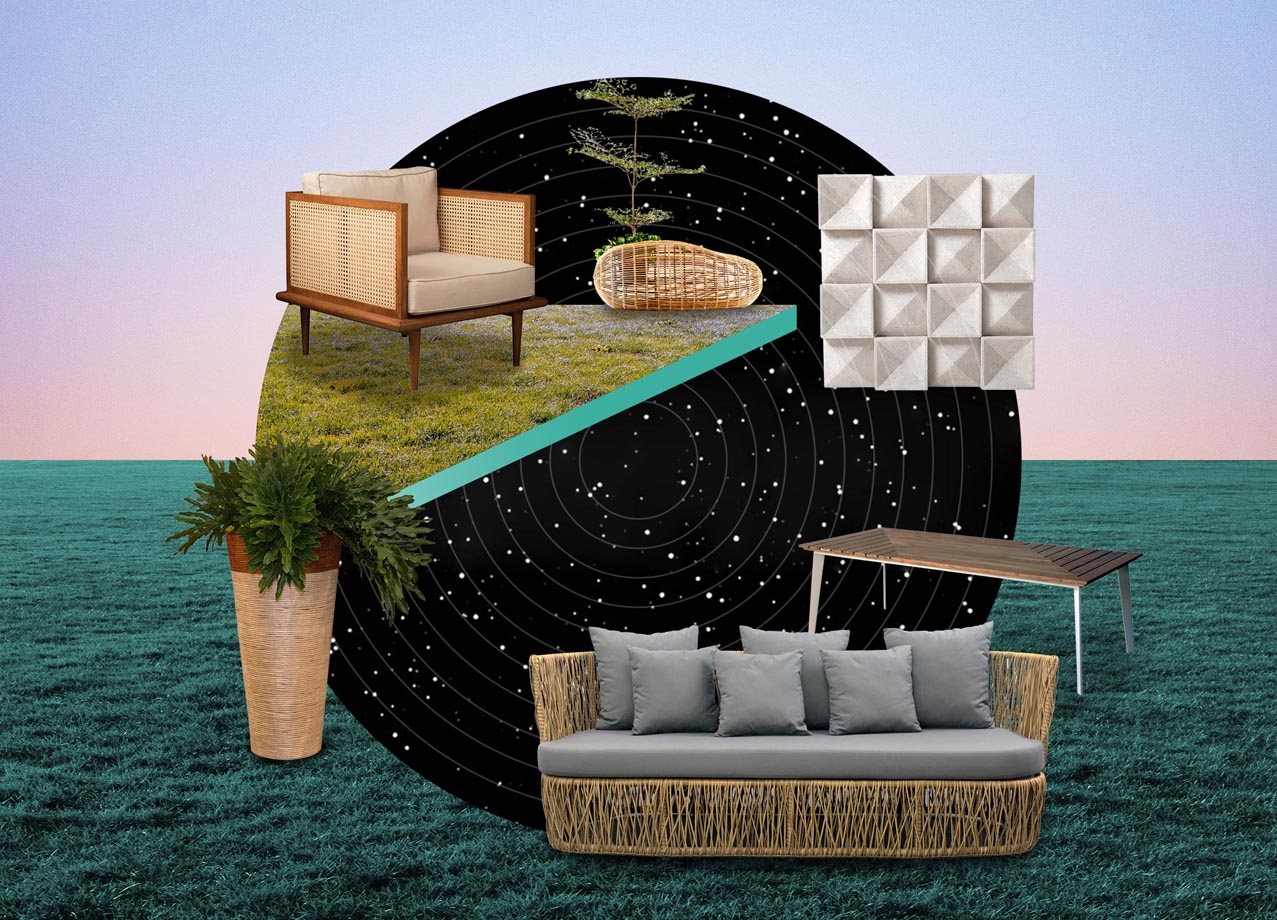
Food for Her Soul
Tina Fernandez can easily engage you in a three-hour conversation about art, but she only needs a few minutes for you to understand its real value. The celebrated gallerist gets real about the local art community and industry—and her real role in it
by Vicky Montenegro
Most people know Tina Fernandez as a gallerist, the maverick behind ArtInformal and Aphro, that many forget—or are not aware—that she is an artist herself. “I was really made aware of Fine Arts in high school,” she recalls. She would visit museums in her travels and at some point had the yearning to learn how to make art. “When I look at an artwork, I can copy it, but the challenge was, ‘how do I make my own?’ So I learned first the process of art making and then, eventually, I started to make my own art. I had my first solo show in Boston Gallery with Dr. Joven Cuanang. And then in Pinto, I think, I had four shows.”
It was perhaps the belief that it is in learning the process that one develops a greater appreciation for the art that Fernandez and some friends, whom she fondly calls “the founders,” established ArtInformal in 2004, not as a gallery, but as a place for workshops for people who are interested in art—viewing, buying, or making them. “It was like a school for art, but not like your regular school,” she shares. “As the name suggests, we figured that the way to teach art or to learn art, to appreciate art and the process of art making, is in an informal setup.”
She also admits to establishing ArtInformal as a response to remarks she’d often hear when going around art galleries and museums. “I would often hear people say, ‘Why is this beautiful? What’s beautiful about it?’ or—especially when the artwork is a minimalist abstract—‘I can do that! My kid can do that!’” she rolls her eyes. “Those remarks really bothered me. So, I said, maybe it would be better if we put up something, like a place where people can gather and discuss art, or learn the process of art making.” Upon opening, ArtInformal offered classes on drawing, painting, sculpture, pottery, and even art appreciation. Fernandez wanted to drive home a point: art has real value.
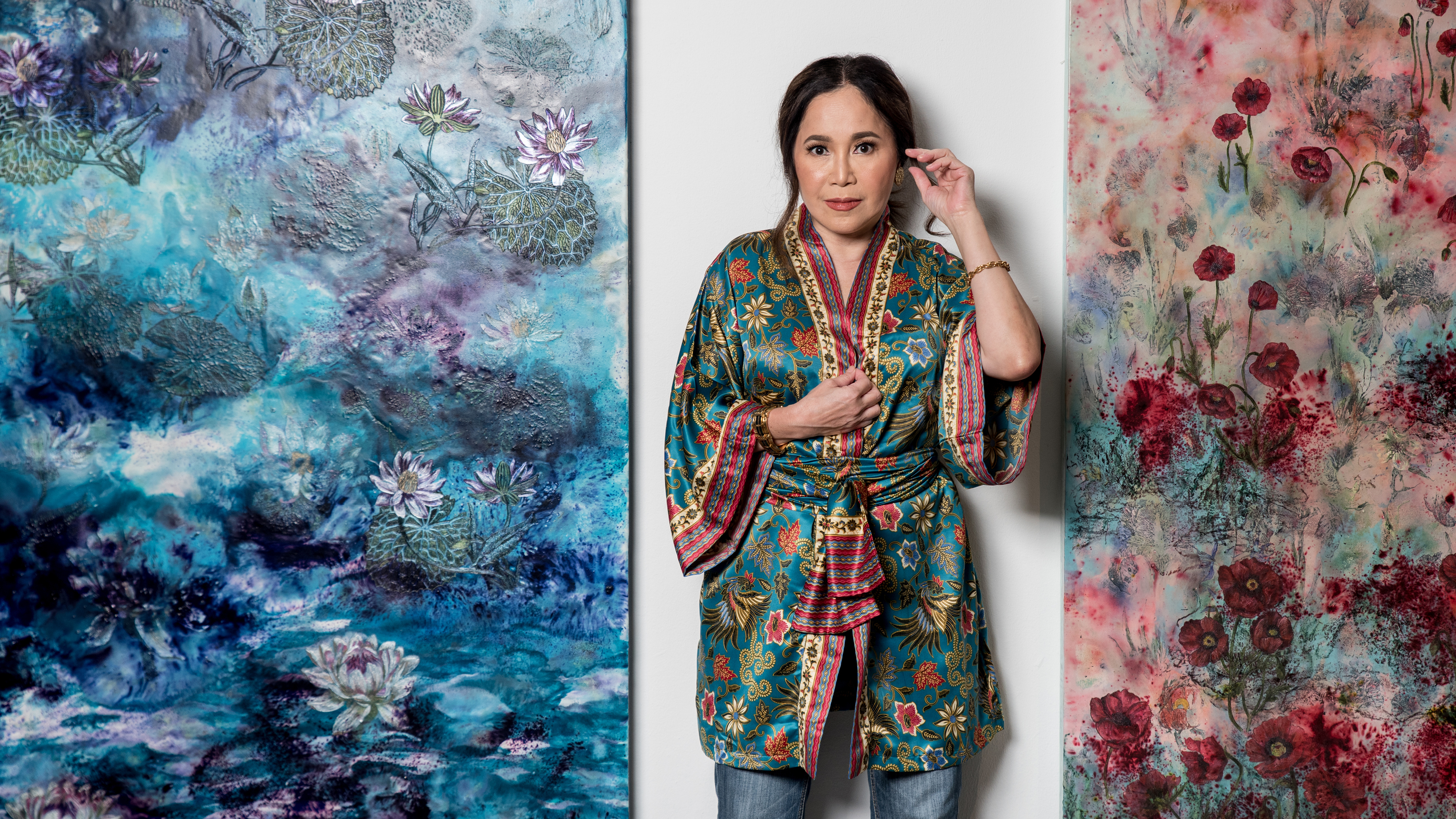
Tina Fernandez established ArtInformal in the family house in Greenhills at a time when almost all galleries were situated in malls. In this photo, she stands between Geraldine Javier’s “Monet and the Wager Lilies I” (left) and “Monet in the Land of Red Poppies,” both 6x6 ft, made of acrylic, powder pigment, encaustic on canvas, shown in the exhibit Five Gardens at Artinformal
ArtInformal’s “classes” would continue until happy hour, with the artist-teachers—John Santos, Pam Yan-Santos, Marina Cruz, Rodel Tapaya, Maria Taniguchi, Cos Zicarelli, Tatong Torres, Riel Hilario, and Joel Alonday, and with Mark Justiniani, Gus Albor, and Bogie Ruiz often dropping by—engaging the students in hearty discussions. “That time, there was a very small pie of collectors. ArtInformal, as a school, I think, widened that pie,” Fernandez says. “As a result of the exchange of ideas, more people who had never really thought of buying art suddenly started to buy art, and started to follow the artists that they met in the gallery.”
From ArtInformal in Greenhills, she put up a second branch in Makati and, beside it, a retail store, Aphro. “The nice thing about Aphro is: for those people who are intimidated to enter a gallery, they can now walk into a store, where they can see art that's created by the same artists that are in the galleries.” Aphro has also become a place for artists who don’t necessarily show in galleries and make different kinds of art and for artists who do show in galleries, but just need a break from the “big or serious shows,” as Fernandez puts it. “Or maybe they just want to have fun and make functional art. So yeah, that's what Aphro is.”
Most recently, Fernandez was busy attending to Jigger Cruz’s and Geraldine Javier’s respective exhibits. She remains hands-on, and personally attends to even the littlest details. “I really care about how these works are translated because I have a lot of respect for these artists.” She will be busy once again in the coming months. In Aphro, they will start doing shows again, including Jon and Tessy Pettyjohn’s—their first together in a long time. Another project in the wings is a book for Cruz, which Fernandez promises to be really one-of-a-kind. “It was designed in such a way that it's inside a wooden box. So you open the box, there's a frame inside, then the book is right in the middle of the frame. And the cover would be individually painted by Jigger.”
“We are also publishing a book for Geraldine’s show because this show of Geraldine deserves a book of its own,” she adds. “It's such a great show. I think this is the best show I've seen in a long time, here and abroad.”
She’s likewise looking forward to ALT Philippines’ first online project, where nine galleries (ArtInformal, Drawing Room, Finale Art File, Vinyl on Vinyl, Blanc, MO_Space, West Gallery, Underground, and Galleria Duemila) have come up with works that will be sold online. The project’s main thrust is to provide 20 college students with full (four-year) scholarships.
In this Creative Dialogue with TouchPoint, Fernandez talks about her real role in the community, the not-necessarily-complex subject of art and commerce, and why art makes us feel alive.
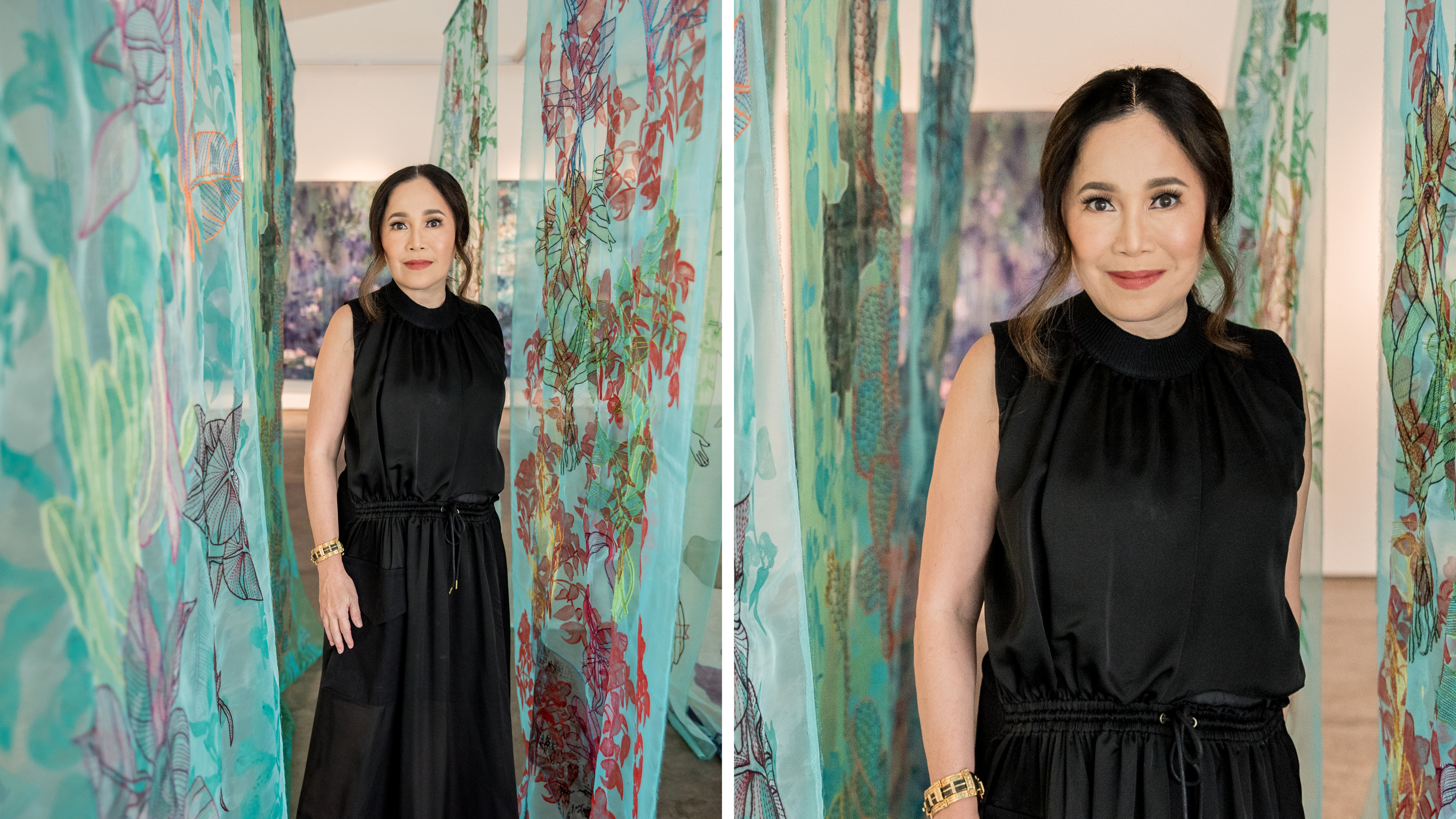
Fernandez most recently showed Geraldine Javier’s Five Gardens show. Seen here is “The Two Fridas” by Javier, an installation made of acrylic, thread, and silk organza
TouchPoint (TP): You’ve said that art has always been part of your life.
Tina Fernandez (TF): Art is always in a person's life. Without you being aware of it, you are surrounded by art. First of all, look around. Look at nature—that in itself is the perfect composition. The Earth itself is instinctively a work of art. So you live with art, whether you like it or not; it's just a matter of being aware of it. And I think that's the reason why some people become artists or designers—it's because they're aware of the beauty of art that already exists. And we learn from nature, and we just translate it into the design of a sofa or a chair, the proportions of a painting, composition. We learned that from nature.
TP: You stopped doing shows and started doing them for other artists. What made you do that?
TF: I realized the art community needs more professional art managers or galleries rather than painters. It was enough for me that I learned from the best. I learned how to make sculptures; I learned how to paint from people that I admire. What I felt the community needed was a more professionally run system. And that's why eventually from being a school, ArtInformal became a gallery because the students started to buy the works of their teachers.
Before, the artists were responsible to print their own invitations; they buy their own cocktails for the event; sometimes they would even bring their own collectors. Basically, the gallery was just a place to show the art. We started to discuss with artists and I said, “Okay, let's try to correct that system, at least here in ArtInformal.” This was around 2006 when we decided to be a gallery, too. So bottom line: all the artists have to do is do their work. The gallery will provide everything. I'm not saying that we were the first to do it, but that's certainly the first thing we did. And I guess the other galleries followed suit after because everyone wanted to show with ArtInformal.
TP: What do you see as your role in the community?
TF: I think the community needs more people who can professionally handle the ecosystem of art in the community—from choosing the artist, from showing the works and finding the right clients who can appreciate that kind of work. And I was in a very good position to do that because I know a lot of people because of my previous job. I like talking with people, so I understand their needs and what they believe is beautiful to them. And if they don't know what's beautiful to them, I expose them to many forms of art, and then they instinctively gravitate toward certain ones. I think my role is… I think the key term is education. I don't sell art. I engage an artist or a client in a discussion—very informally—to determine what their needs are. How do I choose? It's very subjective. It's really just what I like. So there's no fairness there in the sense that I'm not a public institution where I have to be fair. I'm lucky. It's my gallery. I'm the one who chooses, so it's very subjective. It's who I like, it's what I like; it's my taste. It’s things that I would buy myself.
TP: Art is subjective.
TF: It’s very subjective. So whatever anyone considers as art is art. We live with it without us knowing. But you will notice that a home that has some form of art feels good—versus a home that's devoid of it. Art is very soulful. Your soul will recognize it. So it's present, whether you know it or not, whether you can define it as art or not.
TP: So no one can say, “This is not art.”
TF: I think it becomes a question of whether it's arts and crafts or if it's craft or art or fine art. For example, for me, pottery is artisanal. So it's a craft, but it doesn't mean it's not artful or it's not soulful. Pottery is revered in Japan. It takes so long for an artist to master that art. I'm proud to say that ArtInformal, I think, was one of the first galleries to exhibit stoneware, sculptures, and artisanal products. And I think that's one of the reasons why Aphro was created also—because I had to find a place to separate both. It was getting too muddled.
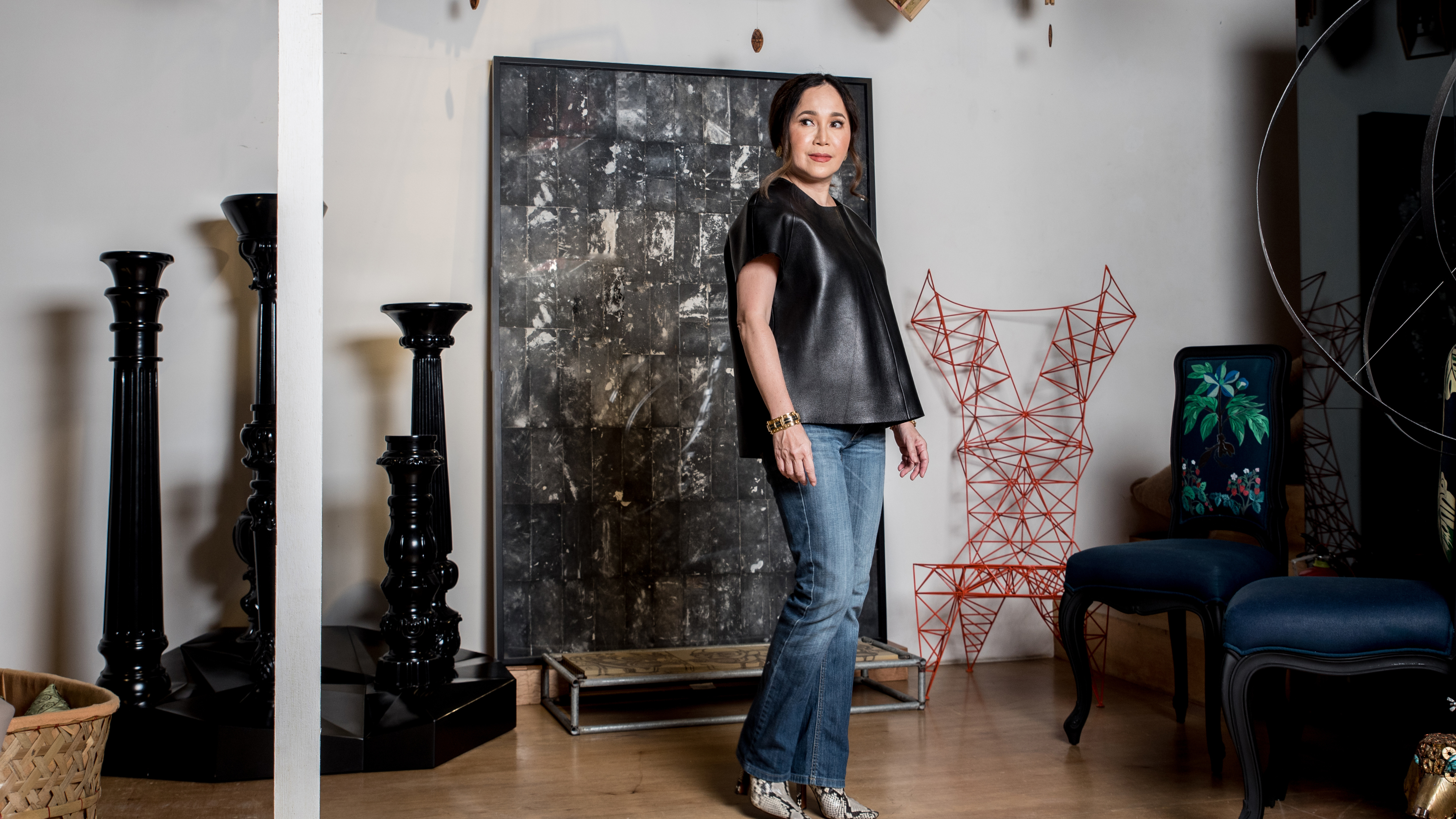
“Basically, ArtInformal is more art, and Aphro is the design part of it,” Fernandez explains. “I remember I asked Erwin Romulo before, ‘What's the difference between art and design?’ He said, ‘Design is practical. Art is not.’ And it’s true!” she laughs. Candleholder installation designed by Rita Nazareno and Gabriel Lichauco for JB Woodcraft; behind Fernandez is a work by Ling Quisumbing
TP: What about a piece gets your attention?
TF: Most of the time, I use my gut and I can't explain why I like something—and it's the same intensity of emotion when I don't like something. Sometimes, I may not be in love with the work, but I love the person. Let's say, if I really like the person, and I understand what the person is doing, the person’s work is excellent, I understand the community that surrounds that person, and I believe in it, then, in order to be part of that community, I show the person's work in Aphro—Aphro is very experimental. So even if I myself won't buy that work, I want to be part of the process of putting together this person's work and finding the right market for that person.
TP: The pieces in Aphro—and, well, most of the ones in ArtInformal, too—are for sale, so let me just broach a topic that’s a bit touchy for some people: art and commerce. Should it even be taboo to talk about it?
TF: Not at all. Everyone needs a livelihood. Everyone needs to make money—and that's why you do what you do.
TP: I think it’s because there’s a fear of being called a “sellout.”
TF: A sellout, to me, is… let's say, I'm the artist, and I want to take advantage of the art market now. I'm going to paint what people like, and I'm going to have a formula. “Oh, they like this? Okay, I'll give them that.” Because it’s mabenta (“easily sold”)—then I will hype it. Basically, a sellout is when the artist just does it for the money, and there’s no more integrity in his work. But, okay, you want to be a businessman? Fine. People will know anyway, but the ones on the losing end are those who will buy your work. I respect artists who are always genuine to their art.
TP: How would you describe the industry now?
TF: It's actually a good time for artists because more and more people are becoming aware of it. You have that entire community of artists, galleries, dealers, auction houses, not just locally, but all around the world. A lot of artists are mad at the auction houses, but they are a necessary evil and they also help in promoting. But yeah, then it leads to people only buying art for investment. Is it bad? Not really. It's part of the entire ecosystem. But if you're going to buy art for investment, you might as well buy good art. So that's where the role of the galleries comes in. We are here to educate people in understanding the art that they're buying.
Every reason to buy art is valid. Again, it's very subjective. So some people will buy for investment, some people will buy because they need decoration at home, and then some people will buy simply because they love the work—whether the artist is known or not. For me, that's a very ideal scenario. For me, that becomes a perfect storm—when somebody likes the work of an artist, and then that artist becomes well-known later on. These are the people that I really appreciate.
TP: Is there anything in particular that you want to see more of?
TF: Yes! I want people to be able to understand installation art more. And that's where the galleries or the museums that can afford to stage installation art come in. Installation art, for me, is a success if you can easily get it. It's a feeling; it's understanding it.
TP: But it's not easily sold. And is it even the goal of the installation artist to have it sold?
TF: No, it's not the goal, but then they would be so happy if somebody gets it and actually pays for it. I mean, a museum, perhaps? It's very rare. They usually end up in museums. But an art installation makes you feel alive. It’s an experience, an emotion that everyone can bring home with them. And I think we lack soul—there's a lack of soul in viewing art these days. It's all about purchasing these days. That has become the preoccupation—rather than the experience.
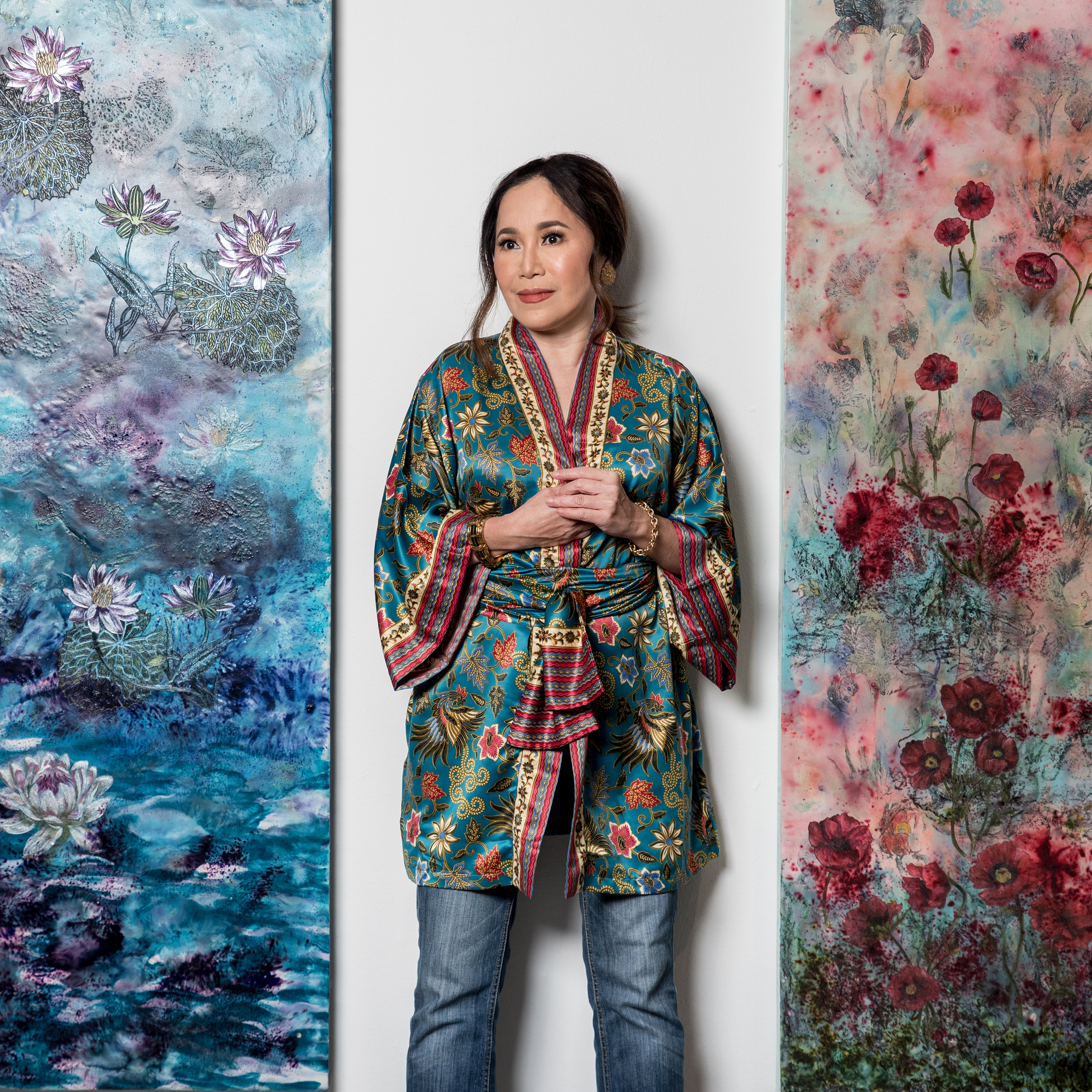
“When the lockdown happened, we had to strengthen our online presence because there was no choice,” Fernandez shares. “Was I able to sell? Yes. Were people buying online? Yes. Were artists happy that they were selling online? Yes—because there was a lot of uncertainty at the time. Is it an ideal setup? No. But are we happy that we were able to do it? Yes. Artists would rather have their works viewed in a gallery setup or in person. What was sad was we had to stop all exhibitions.”
TP: For someone who wants to start collecting, whether they have a big budget or not, how do they begin?
TF: I would recommend for them to view different art forms. Go to different galleries, expose yourself, don't buy anything first. And when you view the exhibit, you don't have to look at each one. What I will do is breeze through an exhibit and then allow my peripheral vision to work. Something will catch your eye and that’s when you come close to the artwork and ask all the questions that you have. Eventually you will find why you're gravitating toward one art form or artwork. Eventually you'll establish your type—because it's communicating with you, there's something in it that you can relate to.
TP: How do you discover new artists?
TF: My discovery of new artists happens very organically. Usually, they're introduced by my roster of artists already, or introduced by someone. I'm very lucky and I'm happy that award-giving bodies in the Philippines have recognized a lot of the younger artists that I have. One of the artists that I totally believe in—and I would tell people before when they asked me, “Who is very promising among the artists that you show?”—is Nice Buenaventura, who is one of the Thirteen Artists Awards awardees.
TP: Who are the newer names everyone should know?
TF: I don't have them at the top of my head and some of them are not necessarily new, but the ones I know of course are Nice Buenaventura, Brisa Amir, Celine Lee, Mars Bugaoan, Monica Delgado, Krista Nogueras, and Ella Mendoza.
TP: So a lot of females.
TF: You know what, I heard a comment from a few curators that it's the female artists these days who are being very innovative and going outside their comfort zone.
TP: If there's an artist who wants to be discovered, can they just approach you?
TF: I actually just accepted one proposal by an artist who I wouldn't otherwise work with if she didn't come up to me and asked. Not because I like the work, but I like that she asked. Again, it's instinctive. Let's just give her a chance—and a bit of pressure. People know that when you show in my gallery, the quality of your work has to be at a certain level. So if it is not, you'll be forced to, and maybe you can squeeze out something that wasn't there before. And if I don't accept them, I always point them to the direction where they're more suited.
TP: In trade shows, a lot of the buyers say they look for “the story” in a product. Do you look for the story behind an artwork, too?
TF: I always have to like the product, whether it's my taste or not. You can see the quality of the product. But, yes, I like to know the history behind it—the whys behind it.
TP: In all your years in the industry, what has been the biggest lesson you’ve learned?
TF: I don't have one thing that I've learned because there are many things to learn every day. But I guess the basic thing is really just to be happy every day. What I learned is actually very basic: if you do what you love, it helps to influence people. When you're doing something you love, you're happy and it shows. If you put your heart into it and you're genuine, the money just follows—because that's not your goal; your goal is something else. And each day, my goal really is to be happy. It's as basic as that.
TP: I always ask my subjects this: What is your dream project?
TF: My house! (laughs) You know why? It’s a dream because I've never built a house before. It’s going to be my house and there won't be paintings. What will there be? Non-paintings. I’m going to give that house a showcase of sculptures and objects. And if I have space, even a small installation project. My other dream project is to build a property in Cuenca, Batangas.
TP: What's your most treasured out of all the pieces you've collected?
TF: I'm not saying it's my favorite, but then it's something that encompasses and speaks volumes about what I do. It's a calling card case, and inside are photographs of artists’ studios, taken by MM Yu. And through the studios, you can tell who the artist is, and it's from A to Z. It’s one of the most precious because it represents what I do—I deal with a lot of artists. So every now and then I like looking at each photograph. It gives me inspiration and it reminds me of how artists work.
TINA’s FAME+ SELECTIONS
